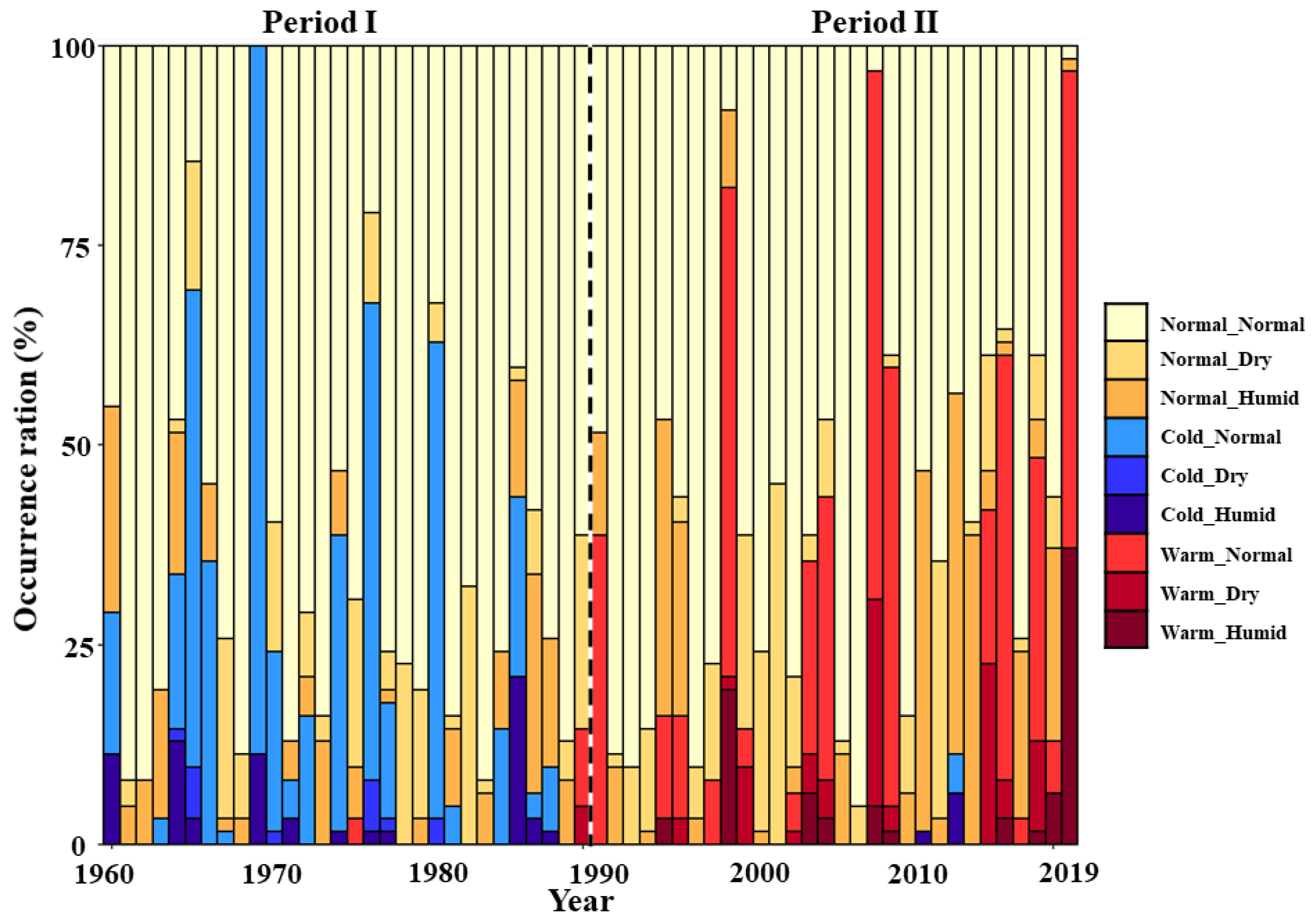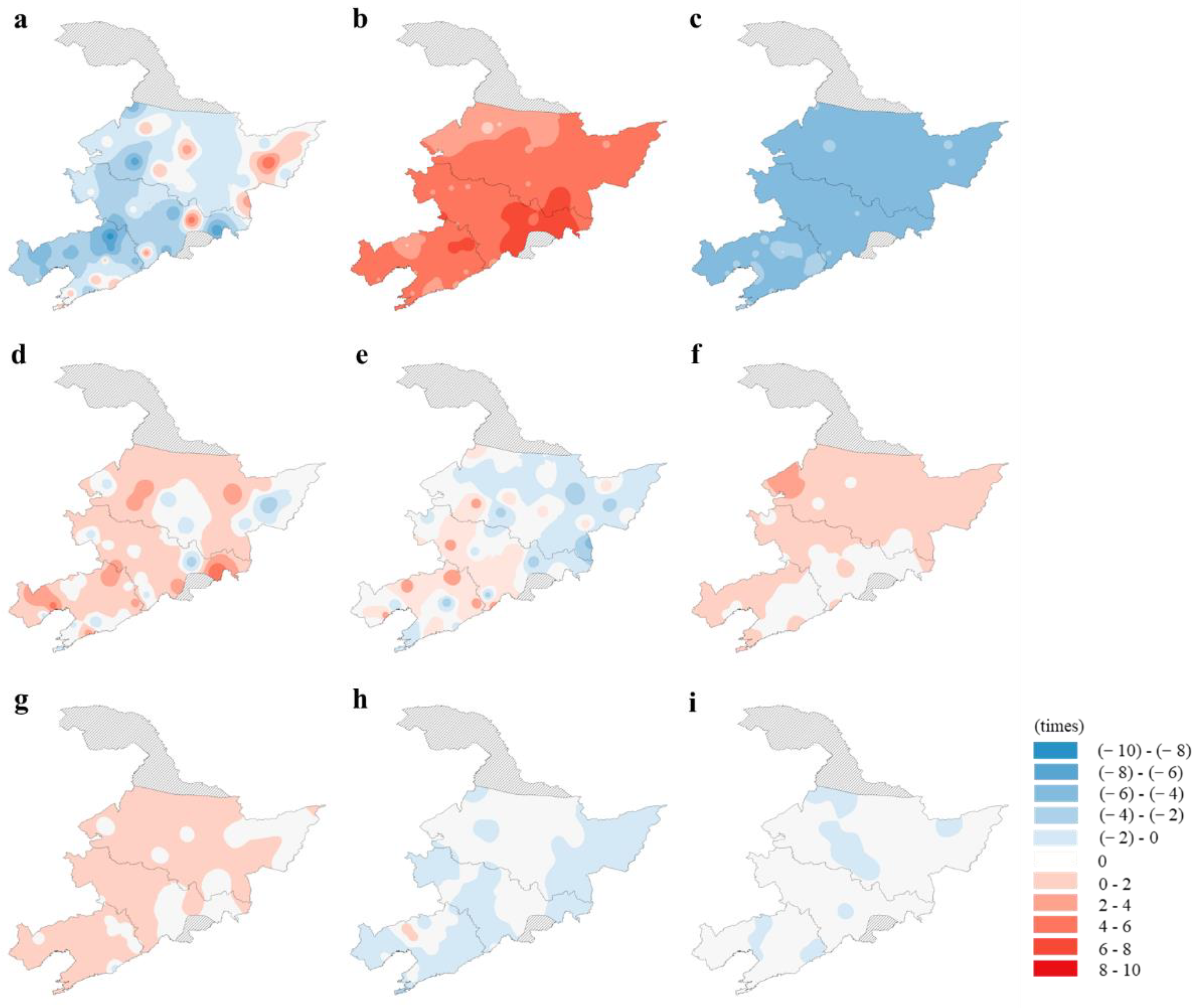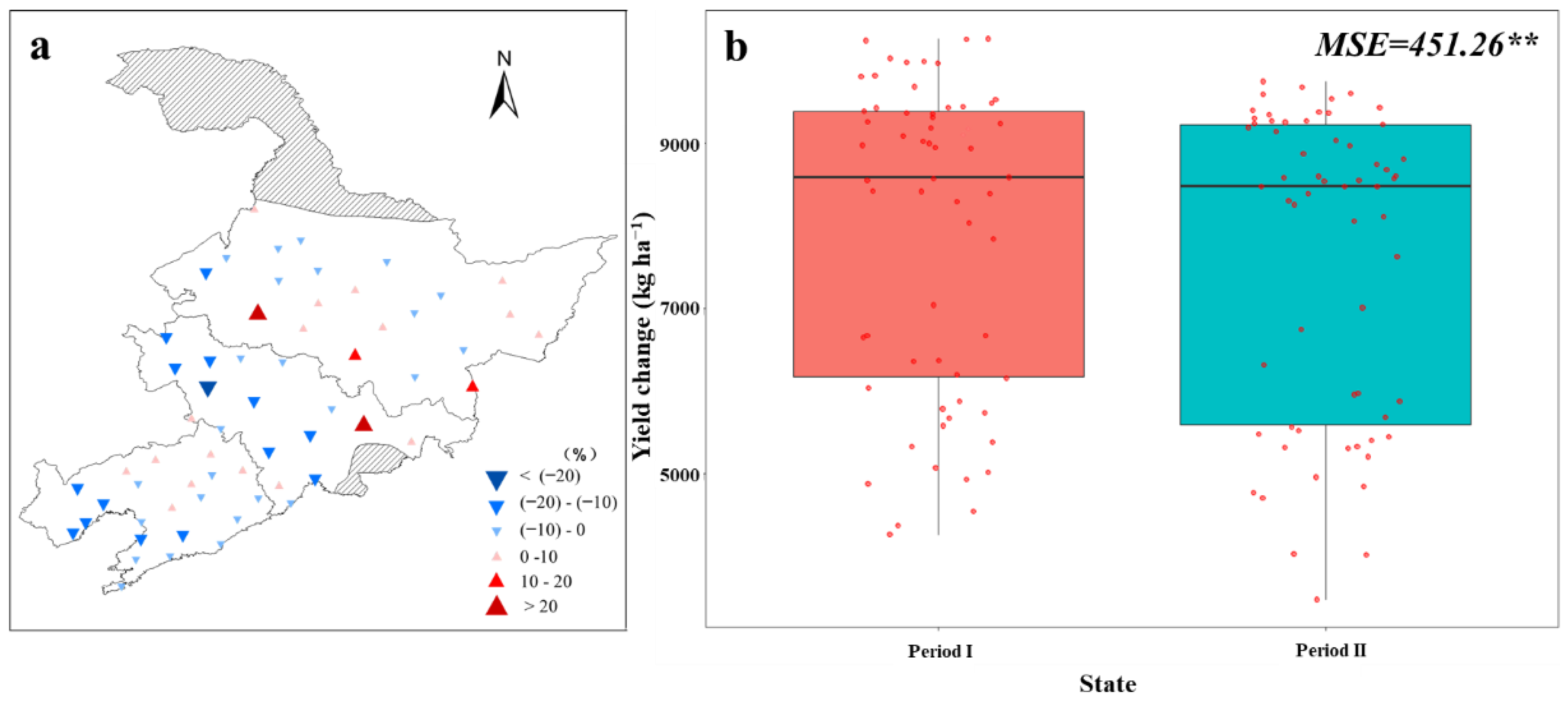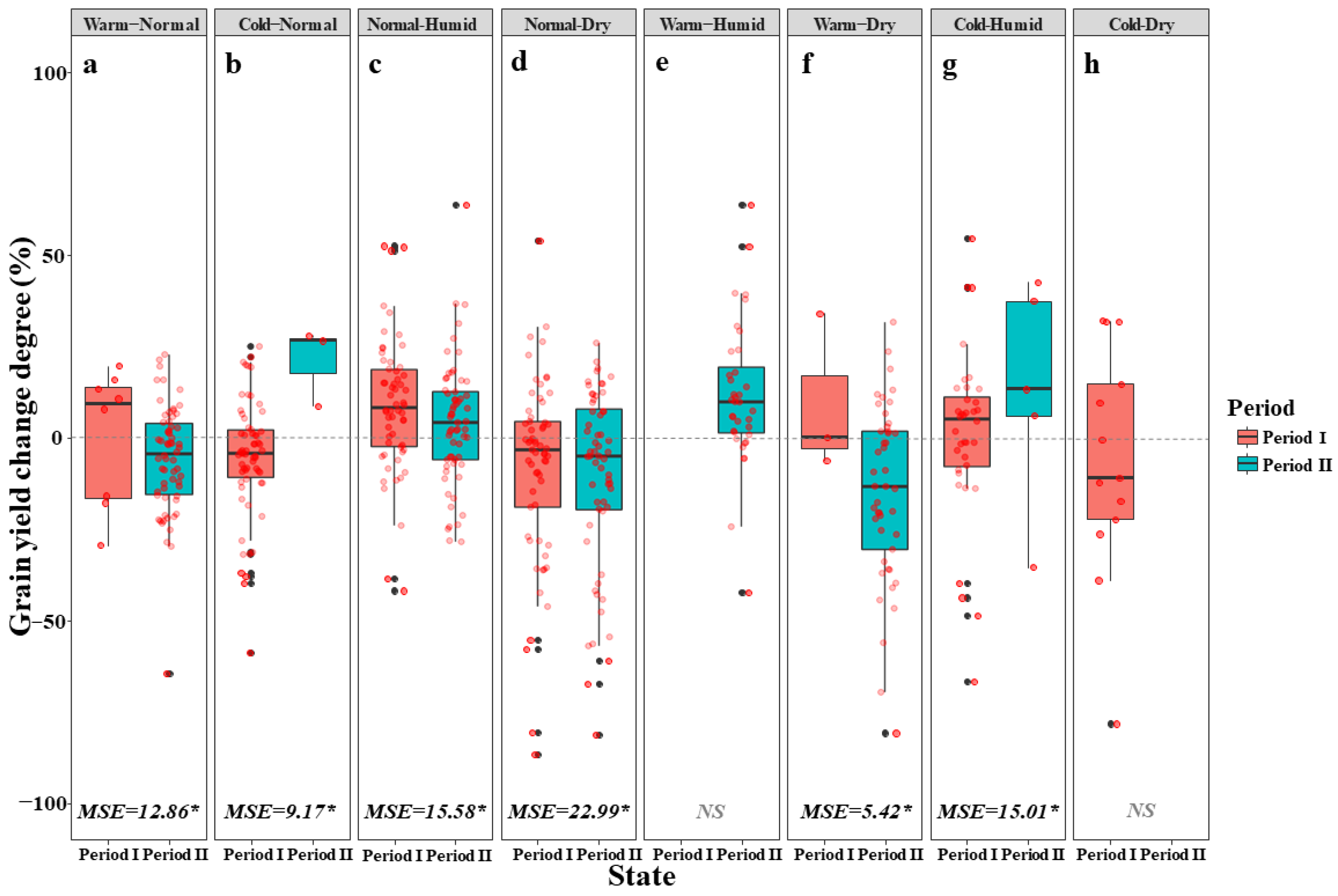Effects of Changing Climate Extremes on Maize Grain Yield in Northeast China
Abstract
1. Introduction
2. Materials and Methods
2.1. Study Area and Climatic Data
2.2. Simulation of Rainfed Potential Yield
2.3. Definitions of Normal Climate and Climate Extremes
2.4. Yield Change Rate Due to Climate Extremes
3. Results
3.1. Validation of the APSIM Model for Simulating the Maize Growth Period and Yield Results
3.2. Normal Climate and Climate Extremes
3.2.1. Annual Variation in Normal Climate and Climate Extremes
3.2.2. Spatial Variation in Normal Climate and Extreme Climate Years
3.3. The Effect of Changing Climate Extremes on Yield
3.3.1. The Effect of a Changing Normal Climate on Yields
3.3.2. The Effect of Changing Climate Extremes on Yields
4. Discussion
5. Conclusions
Author Contributions
Funding
Data Availability Statement
Conflicts of Interest
References
- IPCC. Climate Change 2021: The Physical Science Basis. In Summary for Policymakers; Cambridge University Press: Cambridge, UK, 2021; p. 41. [Google Scholar]
- Otto, C.; Piontek, F.; Kalkuhl, M.; Frieler, K. Event-based models to understand the scale of the impact of extremes. Nat. Energy 2020, 5, 111–114. [Google Scholar] [CrossRef]
- IPCC. Climate Change and Land: An IPCC special report on climate change, desertification, land degradation, sustainable land management, food security, and greenhouse gas fluxes in terrestrial ecosystems. In Summary for Policymakers; Cambridge University Press: Cambridge, UK, 2019; p. 9. [Google Scholar]
- Zhao, D.S.; Zheng, D.; Wu, S.H.; Wu, Z.F. Climate Changes in Northeastern China During Last Four Decades. Chin. Geogr. Sci. 2007, 17, 317–324. [Google Scholar] [CrossRef]
- Liu, J.; Du, H.B.; Wu, Z.F.; He, H.S.; Wang, L.; Zong, S.W. Recent and future changes in the combination of annual temperature and precipitation throughout China. Int. J. Climatol. 2017, 37, 821–833. [Google Scholar] [CrossRef]
- Li, X.Y.; Li, H.Y.; Yang, L.; Ren, Y.X. Assessment of Soil Quality of Croplands in the Corn Belt of Northeast China. Sustainability 2018, 10, 248. [Google Scholar] [CrossRef]
- National Bureau of Statistics of China (NBSC). China Statistical Yearbook; China Statistical Press: Beijing, China, 2021; pp. 399–401. Available online: http://www.stats.gov.cn/tjsj./ndsj/ (accessed on 1 March 2023).
- Niu, X.K.; Xie, R.Z.; Liu, X.; Zhang, F.L.; Li, S.K.; Gao, S.J. Maize Yield Gains in Northeast China in the Last Six Decades. J. Integr. Agric. 2013, 12, 630–637. [Google Scholar] [CrossRef]
- Zhao, J.; Yang, X.G.; Sun, S. Constraints on maize yield and yield stability in the main cropping regions in China. Eur. J. Agron. 2018, 99, 106–115. [Google Scholar] [CrossRef]
- FAO. FAOSTAT: Agriculture; Food and Agricultural Organizations of the United Nations: Rome, Italy, 2019; Available online: https://www.fao.org/faostat/en/#data/QCL (accessed on 2 October 2021).
- Sun, F.; Ding, L.; Feng, W.Q.; Cao, Y.; Lu, F.Z.; Yang, Q.Q.; Li, W.C.; Lu, Y.L.; Shabek, N.; Fu, F.L.; et al. Maize transcription factor ZmBES1/BZR1-5 positively regulates kernel size. J. Exp. Bot. 2021, 72, 1714–1726. [Google Scholar] [CrossRef] [PubMed]
- Feng, W.Q.; Liu, Y.; Cao, Y.; Zhao, Y.R.; Zhang, H.W.; Sun, F.; Yang, Q.Q.; Li, W.C.; Lu, Y.L.; Zhang, X.C.; et al. Maize ZmBES1/BZR1-3 and-9 transcription factors negatively regulate drought tolerance in transgenic Arabidopsis. Int. J. Mol. Sci. 2022, 23, 6025. [Google Scholar] [CrossRef]
- Dowla, M.A.N.N.U.; Edwards, I.; O’Hara, G.; Islam, S.; Ma, W. Developing wheat for improved yield and adaptation under a changing climate: Optimization of a few key genes. Engineering 2018, 4, 514–522. [Google Scholar] [CrossRef]
- Guo, E.L.; Liu, X.P.; Zhang, J.Q.; Wang, Y.F.; Wang, C.L.; Wang, R.; Li, D.J. Assessing spatiotemporal variation of drought and its impact on maize yield in Northeast China. J. Hydrol. 2017, 553, 231–247. [Google Scholar] [CrossRef]
- Tubiello, F.N.; Soussana, J.F.; Howden, S.M. Crop and pasture response to climate change. Proc. Natl. Acad. Sci. USA 2007, 104, 19686–19690. [Google Scholar] [CrossRef]
- Challinor, A.J.; Watson, J.; Lobell, D.B.; Howden, S.M.; Smith, D.R.; Chhetri, N. A meta-analysis of crop yield under climate change and adaptation. Nat. Clim. Chang. 2014, 4, 287–291. [Google Scholar] [CrossRef]
- Yu, X.Y.; Ma, Y.Y. Spatial and Temporal Analysis of Extreme Climate Events over Northeast China. Atmosphere 2022, 13, 1197. [Google Scholar] [CrossRef]
- Guo, S.B.; Guo, E.J.; Zhang, Z.T.; Dong, M.Q.; Wang, X.; Fu, Z.Z.; Guan, K.X.; Zhang, W.M.; Zhang, W.J.; Liu, Z.J.; et al. Impacts of mean climate and extreme climate indices on soybean yield and yield components in Northeast China. Sci. Total Environ. 2022, 838, 156284. [Google Scholar] [CrossRef] [PubMed]
- Zhang, T.Y.; Huang, Y. Impacts of climate change and inter-annual variability on cereal crops in China from 1980 to 2008. J. Sci. Food Agric. 2012, 92, 1643–1652. [Google Scholar] [CrossRef] [PubMed]
- Terjung, W.H.; Ji, H.Y.; Hayes, J.T.; O’Rourke, P.A.; Todhunter, P.E. Actual and potential yield for rainfed and irrigated maize in China. Int. J. Biometeorol. 1984, 28, 115–135. [Google Scholar] [CrossRef]
- Lobell, D.B.; Cassman, K.G.; Field, C.B. Crop yield gaps: Their importance, magnitudes, and causes. Annu. Rev. Environ. Resour. 2009, 34, 179–204. [Google Scholar] [CrossRef]
- Grassini, P.; Yang, H.; Cassman, K.G. Limits to maize productivity in Western Corn-Belt: A simulation analysis for fully irrigated and rainfed conditions. Agric. For. Meteorol. 2009, 149, 1254–1265. [Google Scholar] [CrossRef]
- Asseng, S.; Anderson, G.C.; Dunin, F.X.; Fillery, I.R.P.; Dolling, P.J.; Keating, B.A. Use of the APSIM wheat model to predict yield, drainage, and NO3-leaching for a deep sand. Aust. J. Agric. Res. 1998, 49, 363–378. [Google Scholar] [CrossRef]
- Liu, Y.; Wang, E.L.; Yang, X.G.; Wang, J. Contributions of climatic and crop varietal changes to crop production in the North China Plain, since 1980s. Glob. Chang. Biol. 2010, 16, 2287–2299. [Google Scholar] [CrossRef]
- Liu, Z.J.; Yang, X.G.; Chen, F.; Wang, E.L. The effects of past climate change on the northern limits of maize planting in Northeast China. Clim. Chang. 2013, 117, 891–902. [Google Scholar] [CrossRef]
- Zhao, J.F.; Guo, J.P.; Mu, J. Exploring the relationships between climatic variables and climate-induced yield of spring maize in Northeast China. Agric. Ecosyst. Environ. 2015, 207, 79–90. [Google Scholar] [CrossRef]
- Wang, X.Y.; Yang, X.G.; Sun, S.; Xie, W.J. Comparison of potential yield and resource utilization efficiency of main food crops in three provinces of Northeast China under climate change. Ying Yong Sheng Tai Xue Bao J. Appl. Ecol. 2015, 26, 3091–3102. [Google Scholar]
- China Meteorological Data Network. Daily Observation Data of China Surface Meteorological Station; China Meteorological Administration: Beijing, China, 2021. Available online: http://data.cma.cn (accessed on 11 September 2021).
- Liu, B.H.; Chen, X.P.; Meng, Q.F.; Yang, H.S.; Wart, J.V. Estimating maize yield potential and yield gap with agro-climatic zones in China—Distinguish irrigated and rainfed conditions. Agric. For. Meteorol. 2017, 239, 108–117. [Google Scholar] [CrossRef]
- Zhao, J.; Yang, X.G. Distribution of high-yield and high-yield-stability zones for maize yield potential in the main growing regions in China. Agric. For. Meteorol. 2018, 248, 511–517. [Google Scholar] [CrossRef]
- Allen, R.G.; Pereira, L.S.; Raes, D.; Smith, M. Crop evapotranspiration: Guidelines for computing crop water requirements. United Nations Food and Agriculture Organization, Irrigation and Drainage Paper 56. FAO Rome 1998, 300, D05109. [Google Scholar]
- Wallach, D.; Goffinet, B. Mean squared error of prediction in models for studying ecological and agronomic systems. Biometrics 1987, 43, 561–573. [Google Scholar] [CrossRef]
- Willmott, C.J. Some comments on the evaluation of model performance. Bull. Am. Meteorol. Soc. 1982, 63, 1309–1313. [Google Scholar] [CrossRef]
- Seneviratne, S.; Nicholls, N.; Easterling, D.; Goodess, C.; Kanae, S.; Kossin, J.; Luo, Y.L.; Marengo, J.; McInnes, K.; Rahimi, M.; et al. Changes in climate extremes and their impacts on the natural physical environment. In Managing the Risks of Extreme Events and Disasters to Advance Climate Change Adaptation; A Special Report of Working Groups I and II of the Intergovernmental Panel on Climate Change (IPCC); Cambridge University Press: Cambridge, UK, 2012; p. 111. [Google Scholar] [CrossRef]
- Tingem, M.; Rivington, M.; Colls, J. Climate variability and maize production in Cameroon: Simulating the effects of extreme dry and wet years. Singap. J. Trop. Geogr. 2008, 29, 357–370. [Google Scholar] [CrossRef]
- Gampe, D.; Zscheischler, J.; Reichstein, M.; O’Sullivan, M.; Smith, W.K.; Sitch, S.; Buermann, W. Increasing impact of warm droughts on northern ecosystem productivity over recent decades. Nat. Clim. Chang. 2021, 11, 772–779. [Google Scholar] [CrossRef]
- Guo, E.L.; Zhang, J.Q.; Wang, Y.F.; Quan, L.; Zhang, R.J.; Zhang, F.; Zhou, M. Spatiotemporal variations of extreme climate events in Northeast China during 1960–2014. Ecol. Indic. 2019, 96, 669–683. [Google Scholar] [CrossRef]
- Greve, P.; Orlowsky, B.; Mueller, B.; Sheffield, J.; Reichstein, M.; Seneviratne, S.I. Global assessment of trends in wetting and drying over land. Nat. Geosci. 2014, 7, 716–721. [Google Scholar] [CrossRef]
- Muchow, R.C. Effect of high temperature on grain-growth in field-grown maize. Field Crops Res. 1990, 23, 145–158. [Google Scholar] [CrossRef]
- Khan, M.B.; Hussain, N.; Iqbal, M. Effect of water stress on growth and yield components of maize variety YHS 202. J. Res. Sci. 2001, 12, 15–18. [Google Scholar]
- Li, Y.; Guan, K.Y.; Schnitkey, G.D.; DeLucia, E.; Peng, B. Excessive rainfall leads to maize yield loss of a comparable magnitude to extreme drought in the United States. Glob. Chang. Biol. 2019, 25, 2325–2337. [Google Scholar] [CrossRef] [PubMed]
- Zhang, X.L.; Yan, X.D. Spatiotemporal change in geographical distribution of global climate types in the context of climate warming. Clim. Dyn. 2014, 43, 595–605. [Google Scholar] [CrossRef]
- Prasad, P.V.V.; Staggenborg, S.A.; Ristic, Z. Impacts of drought and/or heat stress on physiological, developmental, growth, and yield processes of crop plants. In Response of Crops to Limited Water: Understanding and Modeling Water Stress Effects on Plant Growth Processes; 2008; Volume 1, pp. 301–355. Available online: https://acsess.onlinelibrary.wiley.com/doi/abs/10.2134/advagricsystmodel1.c11 (accessed on 1 March 2023). [CrossRef]
- Schoper, J.B.; Lambert, R.J.; Vasilas, B.L. Pollen Viability, Pollen Shedding, and Combining Ability for Tassel Heat Tolerance in Maize1. Crop Sci. 1987, 27, 27–31. [Google Scholar] [CrossRef]
- Robertson, M.J.; Carberry, P.S.; Chauhan, Y.S.; Ranganathan, R.; O’Leary, G.J. Predicting growth and development of pigeonpea: A simulation model. Field Crops Res. 2001, 71, 195–210. [Google Scholar] [CrossRef]
- McWilliam, J.R. The national and international importance of drought and salinity effects on agricultural production. Funct. Plant Biol. 1986, 13, 1–13. [Google Scholar] [CrossRef]
- Smeets, E.M.W.; Faaij, A.P.C.; Lewandowski, I.M.; Turkenburg, W.C. A bottom-up asse, ssment and review of global bio-energy potentials to 2050. Prog. Energy Combust. Sci. 2007, 33, 56–106. [Google Scholar] [CrossRef]
- Pretty, J. Agricultural sustainability: Concepts, principles and evidence. Philos. Trans. R. Soc. B Biol. Sci. 2008, 363, 447–465. [Google Scholar] [CrossRef] [PubMed]







| Province | Site | Year |
|---|---|---|
| Heilongjiang | Harbin | 1994, 2002, 2011, 2014 |
| Jilin | Siping | 1985, 2009, 2011, 2013, 2014 |
| Jiaohe | 1993, 1994, 2007, 2010, 2014 | |
| Liaoning | Shenyang | 1999, 2000, 2008, 2011 |
| Item | Validation | |||
|---|---|---|---|---|
| R2 | RMSE | NRMSE (%) | D | |
| Number of days from sowing to flowering (d) | 0.79 | 9.72 | 12.62 | 0.92 |
| Number of days from flowering to maturity (d) | 0.75 | 9.91 | 7.69 | 0.92 |
| Grain yield (kg ha−1) | 0.88 | 503.66 | 7.36 | 0.96 |
| Climate Extremes | Normal-Normal | |
|---|---|---|
| Period I | Period II | |
| Warm-normal | 1046.36 | 756.85 ** |
| Cold-normal | 974.41 ** | 470.52 * |
| Normal-humid | 884.02 ** | 812.71 |
| Normal-dry | 1380.27 ** | 1203.62 ** |
| Warm-humid | — | 969.50 ** |
| Warm-dry | 1238.54 | 1235.71 ** |
| Cold-humid | 1205.91 | 1541.12 |
| Cold-dry | 1828.70 * | — |
Disclaimer/Publisher’s Note: The statements, opinions and data contained in all publications are solely those of the individual author(s) and contributor(s) and not of MDPI and/or the editor(s). MDPI and/or the editor(s) disclaim responsibility for any injury to people or property resulting from any ideas, methods, instructions or products referred to in the content. |
© 2023 by the authors. Licensee MDPI, Basel, Switzerland. This article is an open access article distributed under the terms and conditions of the Creative Commons Attribution (CC BY) license (https://creativecommons.org/licenses/by/4.0/).
Share and Cite
Dong, M.; Zhao, J.; Li, E.; Liu, Z.; Guo, S.; Zhang, Z.; Cui, W.; Yang, X. Effects of Changing Climate Extremes on Maize Grain Yield in Northeast China. Agronomy 2023, 13, 1050. https://doi.org/10.3390/agronomy13041050
Dong M, Zhao J, Li E, Liu Z, Guo S, Zhang Z, Cui W, Yang X. Effects of Changing Climate Extremes on Maize Grain Yield in Northeast China. Agronomy. 2023; 13(4):1050. https://doi.org/10.3390/agronomy13041050
Chicago/Turabian StyleDong, Meiqi, Jin Zhao, E Li, Zhijuan Liu, Shibo Guo, Zhentao Zhang, Wenqian Cui, and Xiaoguang Yang. 2023. "Effects of Changing Climate Extremes on Maize Grain Yield in Northeast China" Agronomy 13, no. 4: 1050. https://doi.org/10.3390/agronomy13041050
APA StyleDong, M., Zhao, J., Li, E., Liu, Z., Guo, S., Zhang, Z., Cui, W., & Yang, X. (2023). Effects of Changing Climate Extremes on Maize Grain Yield in Northeast China. Agronomy, 13(4), 1050. https://doi.org/10.3390/agronomy13041050





